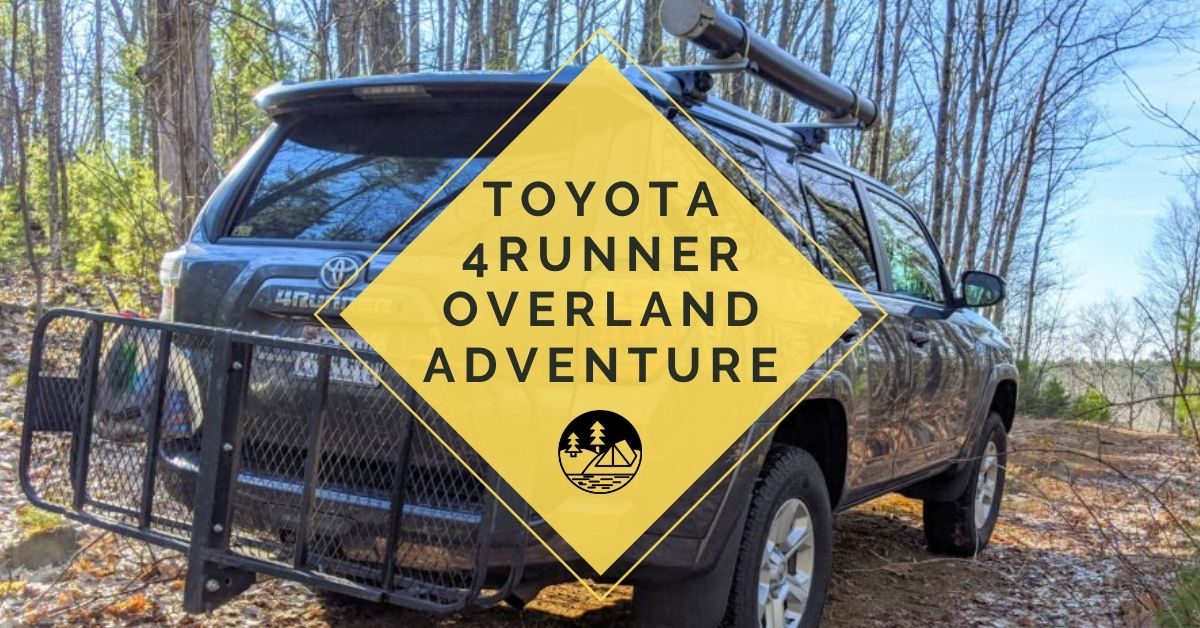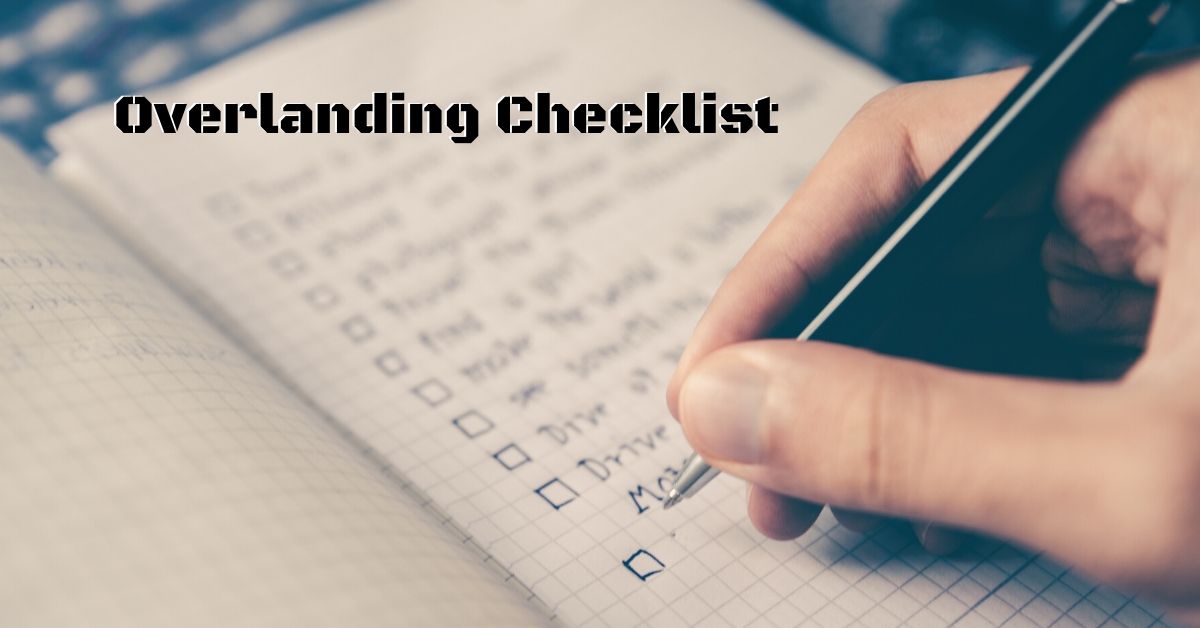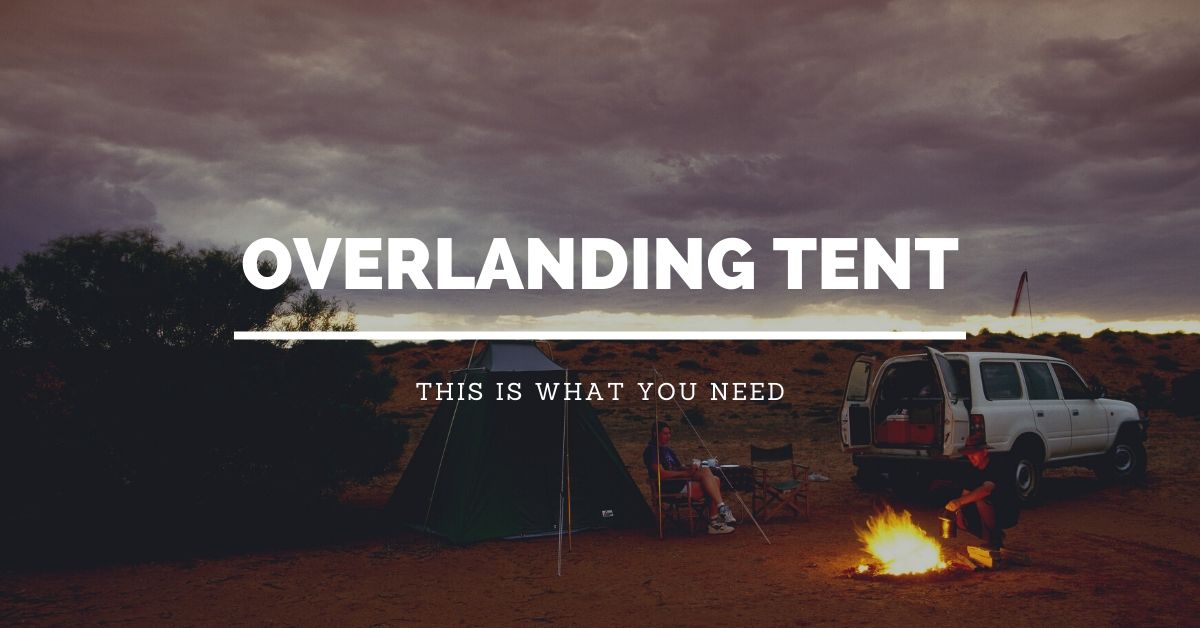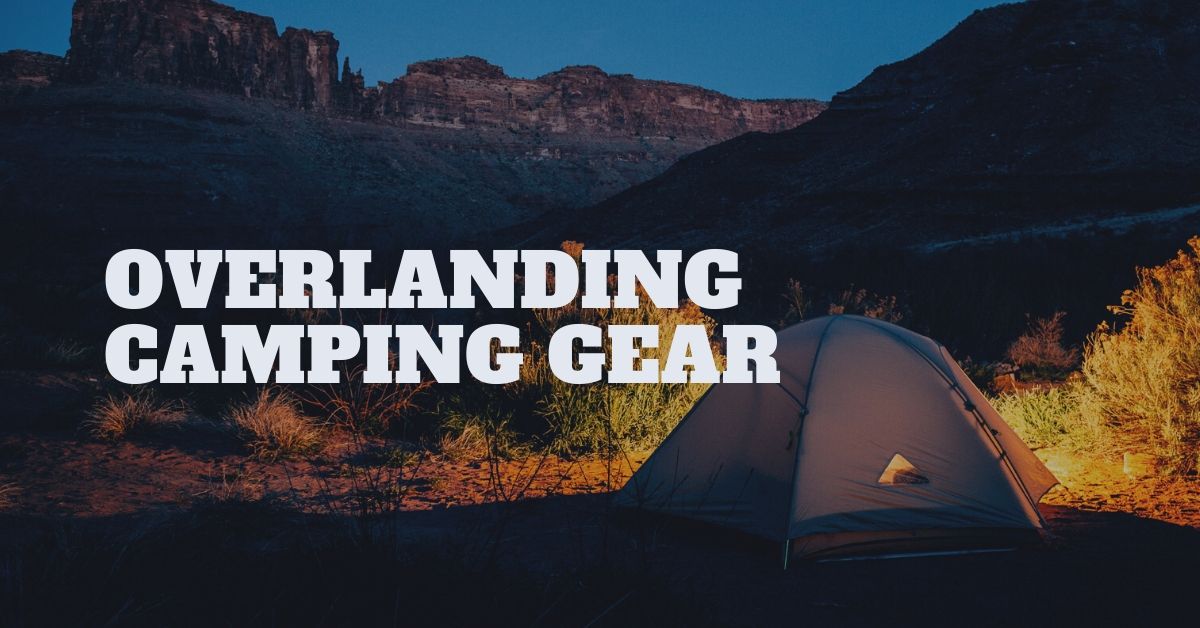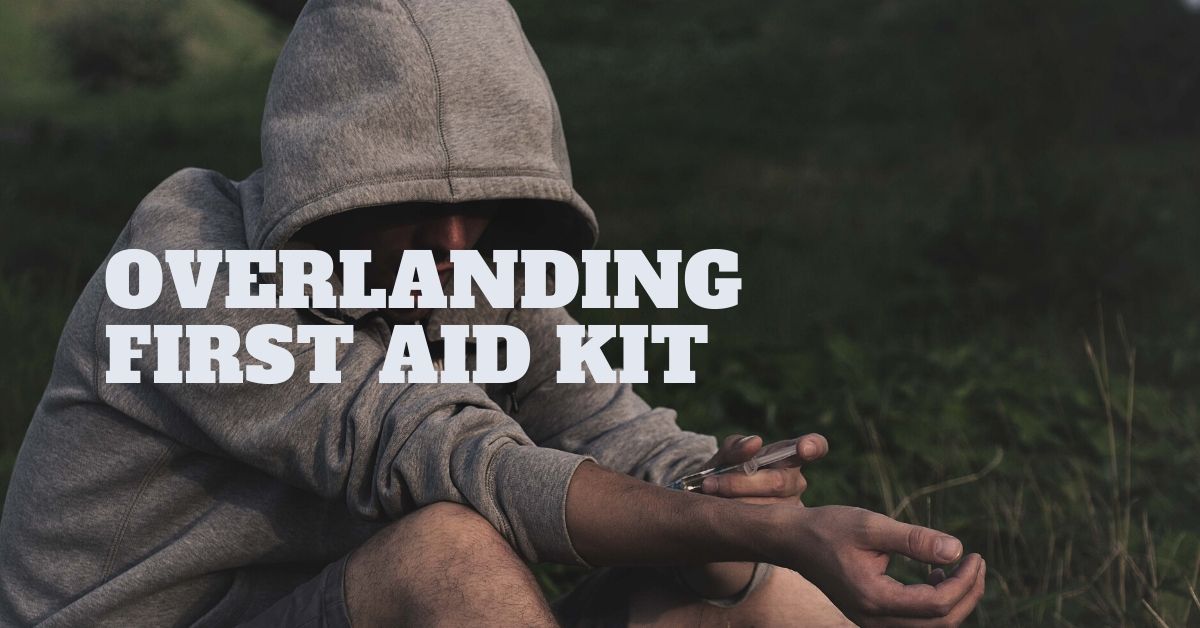“You’re not camping – that looks like overlanding to me!” This was the response I got when I sent a fellow survival-oriented colleague some pictures of the trip I took with my 6-year-old son this weekend to the wilds of Maine. It’s funny – I’ve been doing stuff like this for 35 years – ever since I was my son’s age – and we just called it “camping” or “fishing” or whatever. Now I learn there’s this big wide term – “Overlanding” and what I do is what it is. Go figure.
Hotel Toyota: Introduction to Overlanding with a 5th Gen 4Runner
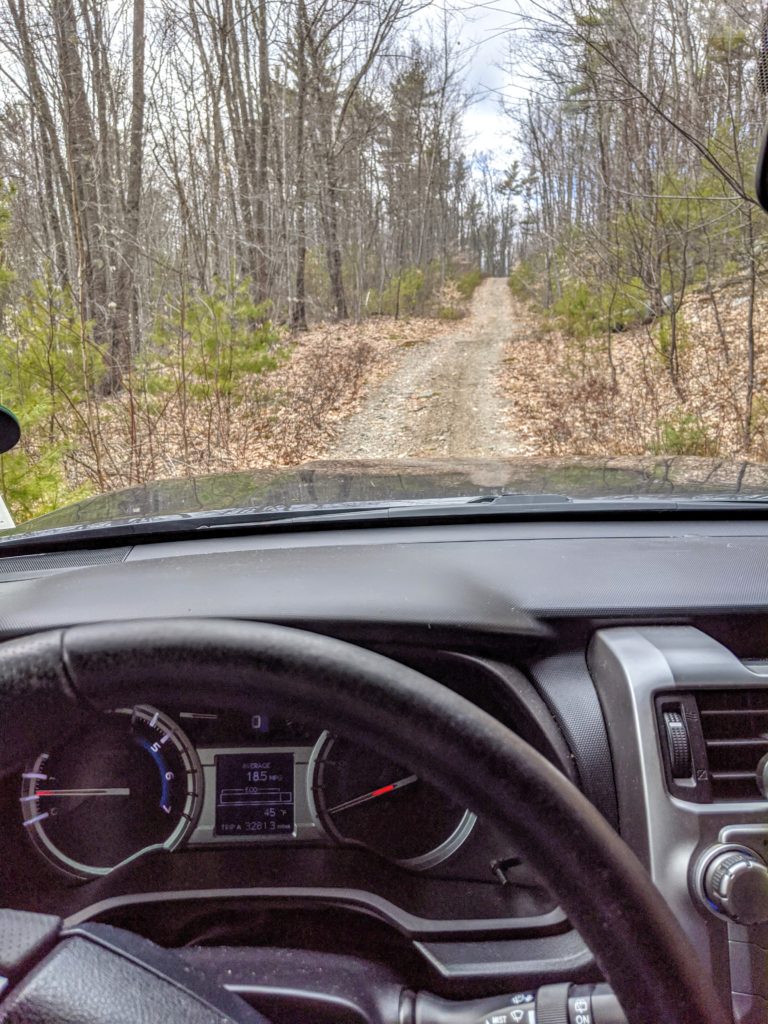
When I was a little whippersnapper, my father, younger brother, and I would bomb down dirt roads in my father’s maroon 1983 Oldsmobile Custom Cruiser station wagon, affectionately dubbed “Red One”. The long wheelbase and cushy tall whitewalls absorbed bumps and bangs with ease, as long as we were careful not to push the trail-riding envelope that only a B-body GM station wagon offers. When we were done for the night, we flipped down the tailgate to provide a landing pad for our butts, built a fire, and cooked fish, red hot dogs (A Maine delicacy) on a stick and burned Dinty Moore in an ancient cast iron pot that permanently lived in the back of the station wagon. When we were done, we cleaned up in a stream or with gallon jugs of water, folded down the back seat and way-back “gunner’s” seat (remember those?) and we all piled in with hand-me-down sleeping bags and slept the night away in the capacious cargo area of the station wagon. There were many fond memories that I will always treasure, built on out-of-the-way trout streams, native brookies frying in butter, and morning condensation on Oldsmobile windows.
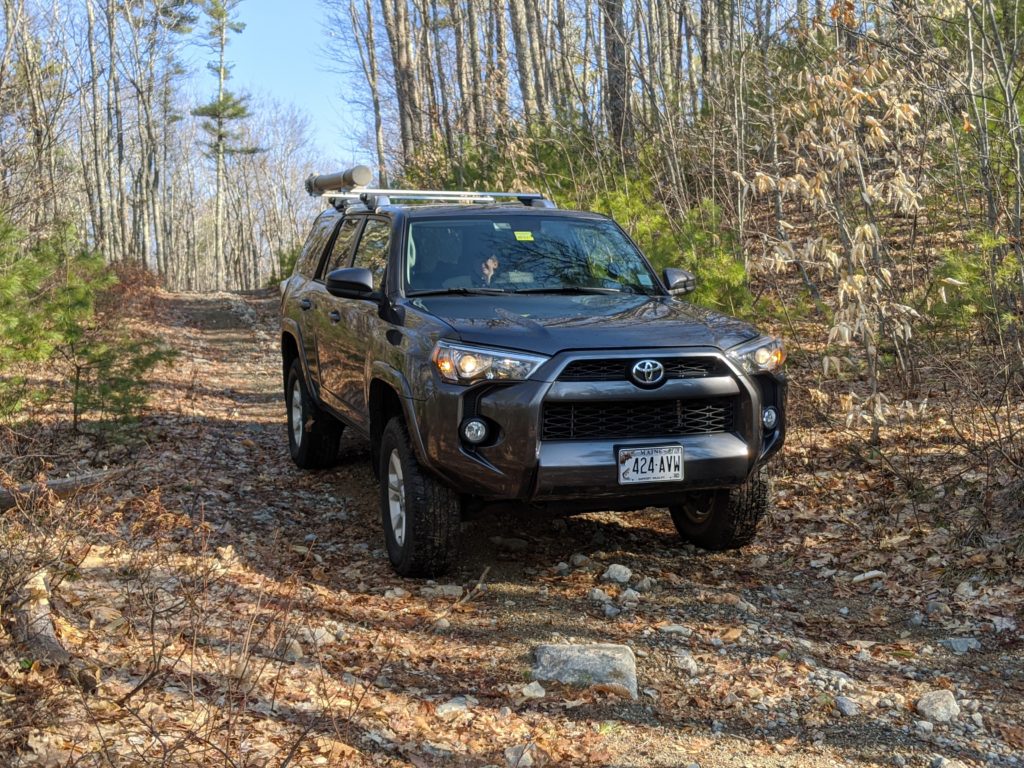
These memories – and the desire to ensure my son has similar fond memories of the outdoors in our beautiful state – drove me to sell my beloved 2004 Xtracab 4×4 Toyota Tacoma which I’d put over 200,000 miless on personally, so that I could buy a vehicle with extra adventuring cargo capacity. The stalwart old Tacoma went anywhere and never let me down – but without a cap, it was limited in many ways – especially once my young son and all the related accessories started to come along on my excursions into the wild.
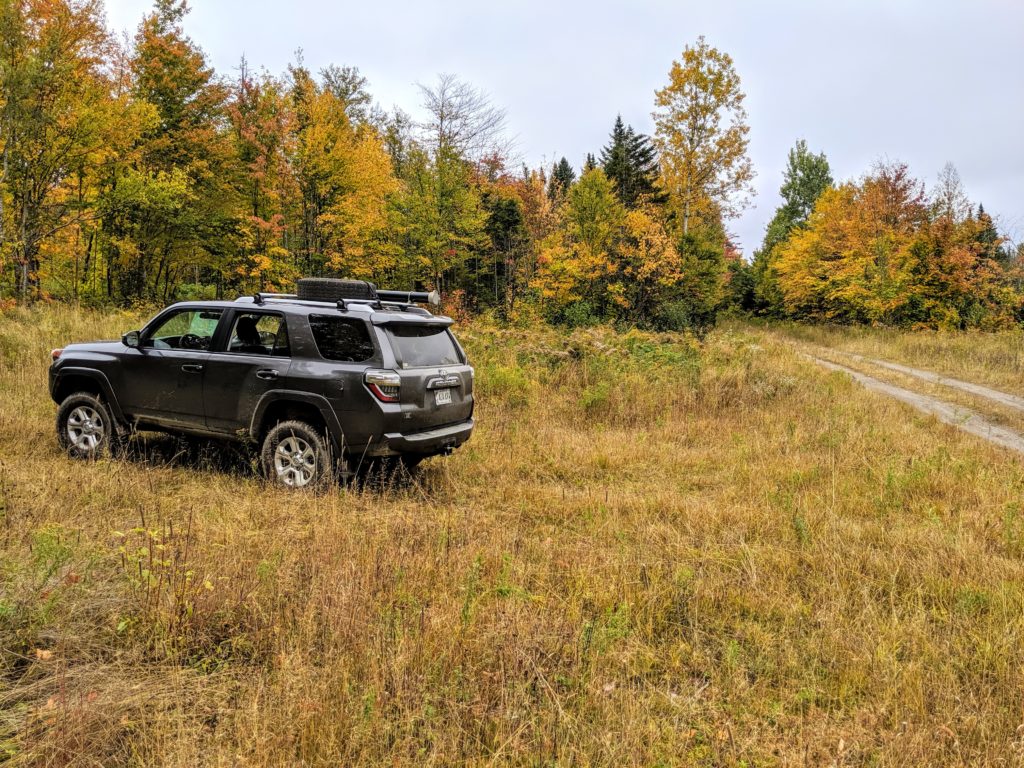
As a replacement, I eventually purchased a used, but well cared for and meticulously maintained 2014 (Gen 5) Toyota 4Runner SR5. Yeah, there weren’t lockers and BFG KO2s and KDSS and all the extra sexy stuff, but it was what I could afford and it fit the bill perfectly. The salesman thought me odd indeed when I fiddled around with the back seats until they folded down, and then climbed in and laid down in the cargo area before I said I’d take it. “Hey pal, shut that door so I see if I fit inside…”
5th Gen 4Runner Overland Build
I haven’t done much to the 4Runner in the 10 months or so I’ve owned it – it still rides on the (admittedly pretty good) Yokohama Geolandar A/T G015 tires the truck came with, no performance mods or anything crazy. The only additions I’ve made are Bilstein 5100 shocks all the way around and a Daystar spring cup kit out back to lift the back of the rig about 1 ½” and the front about 2 ½” once settled, plus some inexpensive aluminum roof racks and 5” diameter capped tube I built as a multi-purpose utility apparatus – it holds fishing rods, a tarp for an awning, etc. I’m sure the modification saga is far from complete, but that’s where she sits as of now (4/21/2020).
Transforming an SUV into a Mobile Ramada
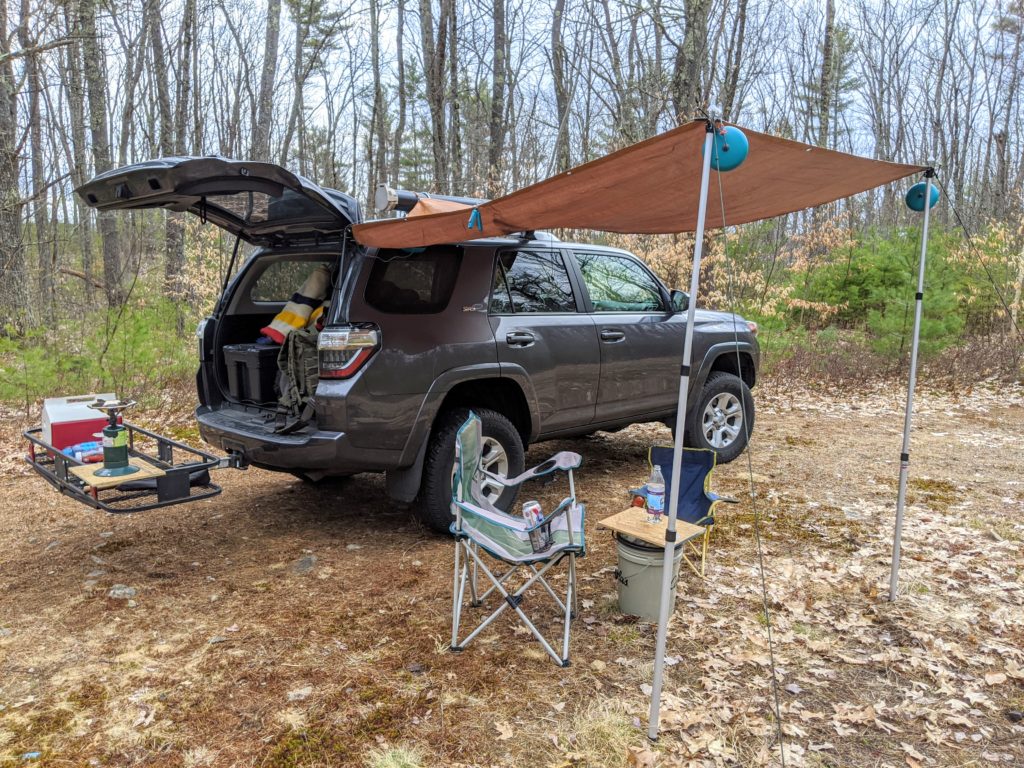
While I’d taken the 4Runner into the woods before on various hunting and fishing trips, it was primarily a mode of transportation to get to the end destination, then come back. As the inaugural run of “Hotel Toyota” (a term coined by our own Doc Montana after seeing the pictures), I was excited to see how the 4Runner would fare as a mobile housing unit. The square footage was there once the rear seats folded down, though the length was a bit shy for me. I’m 6 feet tall, and the rear cabin length of the 4Runner ended up being about 5’-10”, so some creativity would be required – especially if I ended up bringing a travel companion with me and they needed room as well.
To baseline and start a foundation to grow from, I went with what I knew: sleeping bags and wool blankets. My boy and I set up the awning and made camp, got plenty of firewood processed thanks to a sharp hatchet and Silky Saw, and then whipped up a quick meal of hot dogs and baked beans after starting a cheery fire. About an hour before dark, I relocated the gear from the cargo area to the front seats and under the 4Runner, and folded down the seats to make ready for the evening’s slumbering activities.
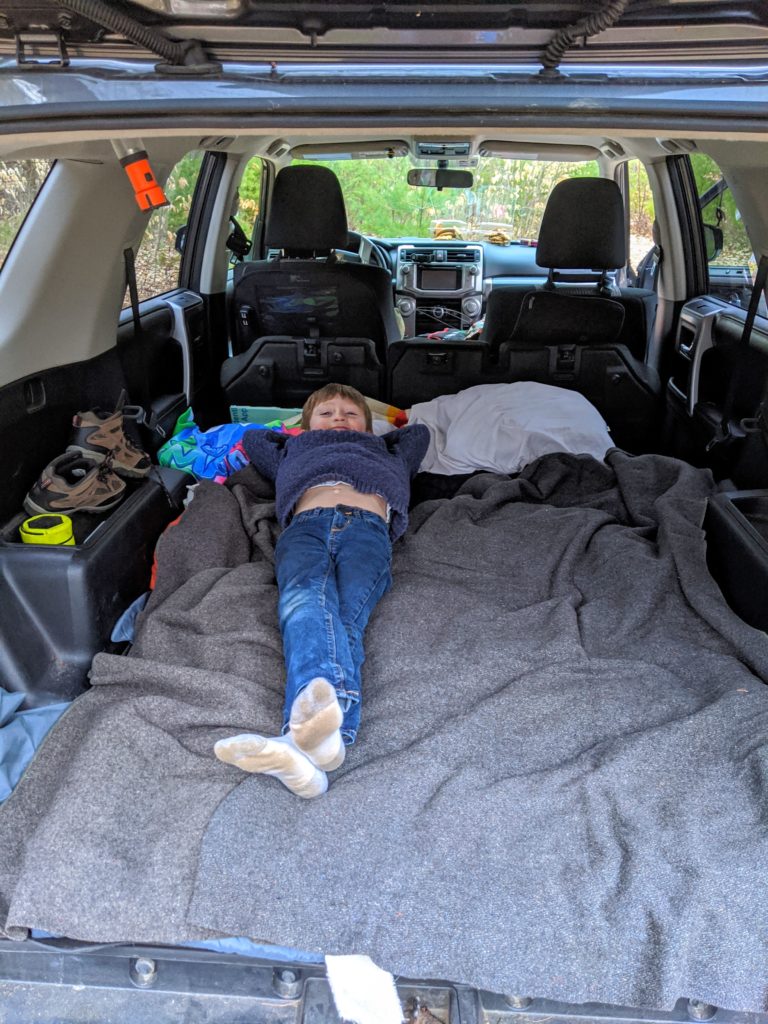
Thick wool blankets went down first for padding. Our sleeping bags went next, then two USGI wool blankets rounded out the warmth accoutrements. The temperature was supposed to get down to about 27 degrees Fahrenheit that evening, so I made sure there were plenty of layers so lil’ Dude and I didn’t end up running the truck all night with the heat cranked. Pillows were thrown, my boy inspected and approved the bedding, and we settled down for some cutthroat games of Go-Fish as the fire crackled and warmed us while we laughed under the crisp Maine night and watched the Big Dipper slowly march across the sky.
Let the Pain Games Begin!
When we decided it was time to call it a night, we crawled in and tested the new digs. My son loved it and loudly proclaimed, “This is the best night ever!” which tempered my increasingly sour attitude as the night wore on. Don’t get me wrong, we were warm and the truck was a perfect size – my son zonked right out and slept the night through – but things weren’t so hunky dory for me and my 40-year-old bones.
The length of the cargo area wasn’t as huge a deal as I thought it’d be – I just laid diagonally across the back; sometimes I slept on my side in a fetal position – and it (mostly) worked fine. Okay, maybe “slept” isn’t a great word, because, well, the floor in a 4Runner isn’t completely flat once the rear seats are folded down. At the hinge location where the seats pivot, the floor raises about, oh, an inch and a quarter or so, making the rearmost part of the compartment lower than the front. This ridge happened to be located at approximately my fifth pair of ribs from the bottom, so there was no way I was going to bend or flex to make myself comfortable. Sleeping on my stomach was about the best way to go, I found. But it was a long, miserable, physically uncomfortable night. I contemplated moving some gear from the front seat to the back next to my kid, then snoozing in one of the front seats, but I knew I’d wake up little dude and he’d just want to sleep in my lap. So I soldiered on through the night. Sometimes being a Dad is tough.
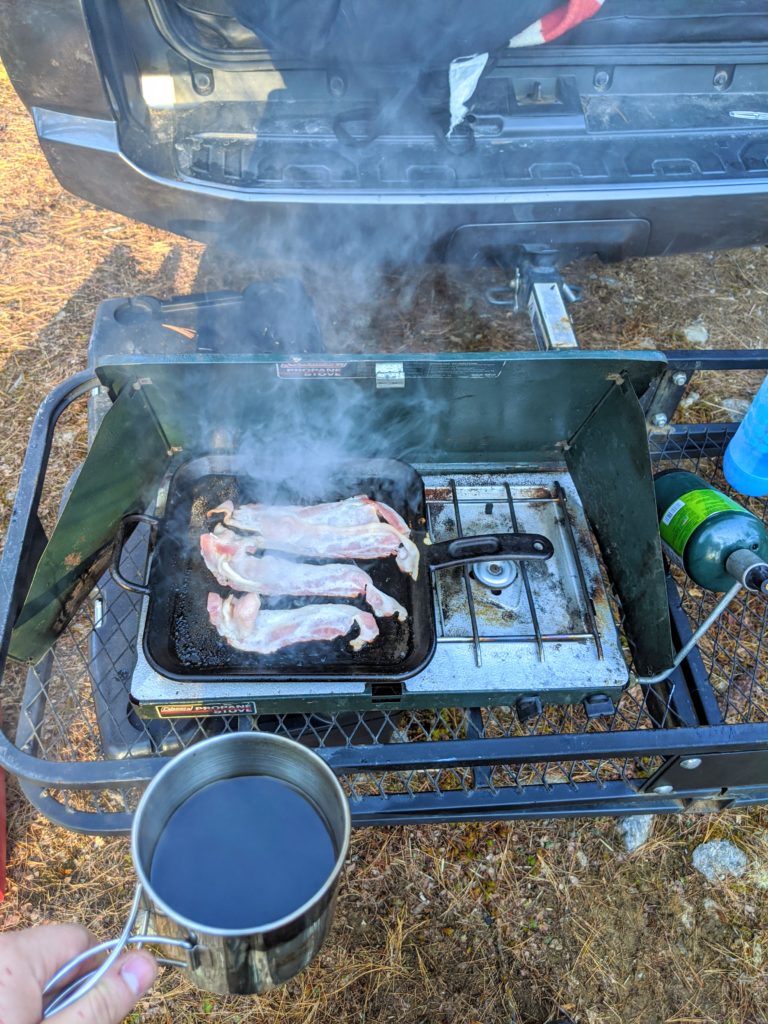
Dawn couldn’t come soon enough, and as soon as the sun started peeking over the hemlocks – about 6:15 am – I threw my boots on and headed out the door for a good stretch and to hit some ibuprofen while the camp percolator did its thing to whip up some of the magical elixir that is piping hot camp coffee.
Oh yeah, speaking of heading out the door – I had to crawl out through one of the side passenger doors; my 4Runner’s rear hatch doesn’t have an inside-accessible door handle. I had also locked the doors at my son’s request (to keep bears out, interestingly), and found that I had to ooze my hurting body over the front seats to reach the door locks to let myself out; I had left the keys and the key fob in the ignition in case I had to start the truck to warm up overnight. Lesson learned.
The Morning After
Once I extricated my sorry body out of the 4Runner and got moving in the sunshine, life got better. Soon bacon and eggs were crackling while I drank my beloved camp java, and my son mixed up some just-add-water Krusteaz pancake mix to make sure he got a big ol’ helping of Dad’s special “Sorry I burned these the cast iron skillet was too hot” flapjacks.
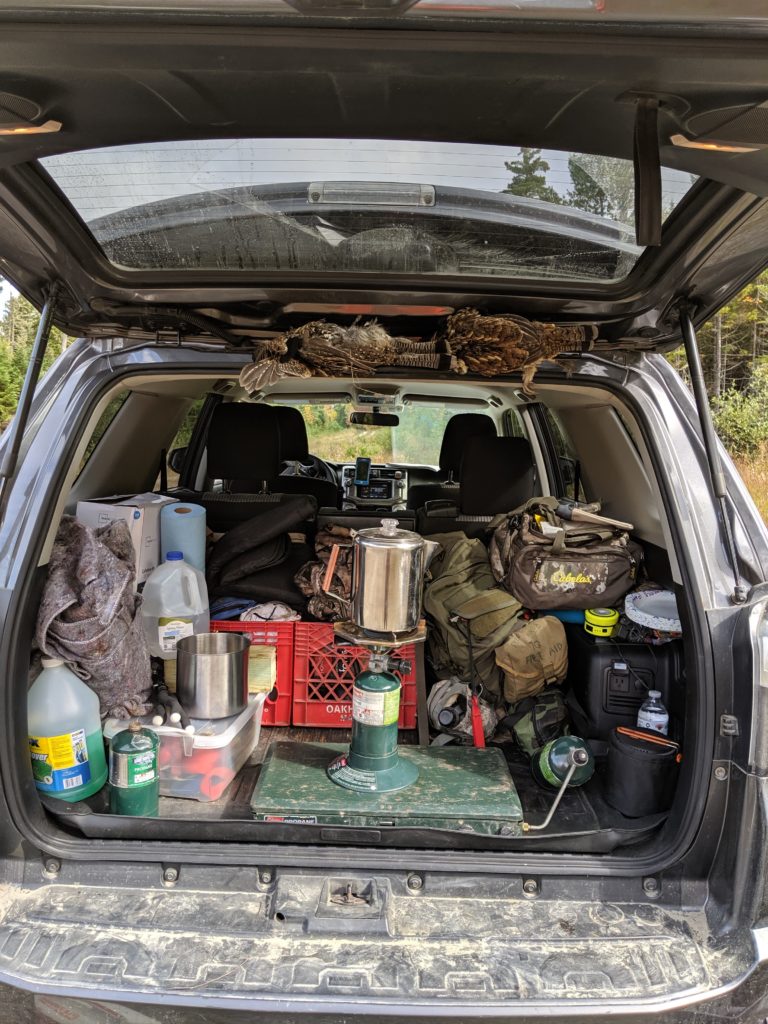
Bellies full, we had a nice relaxed morning re-packing all the gear into the 4Runner after the blanketry was squared away. I was really impressed with the whole 4Runner cargo capability – my old Tacoma, while agile off-road, would never have let us carry all this gear in a comfortable, dry fashion – let alone provide sleeping arrangements.
Once we departed our camping area, we did some enthusiastic bombing around the local trails and stopped at a local fishing hole to drown some worms and lose some Roostertails in pursuit of trout. A great day and evening indeed…and a template for future outings with my son.
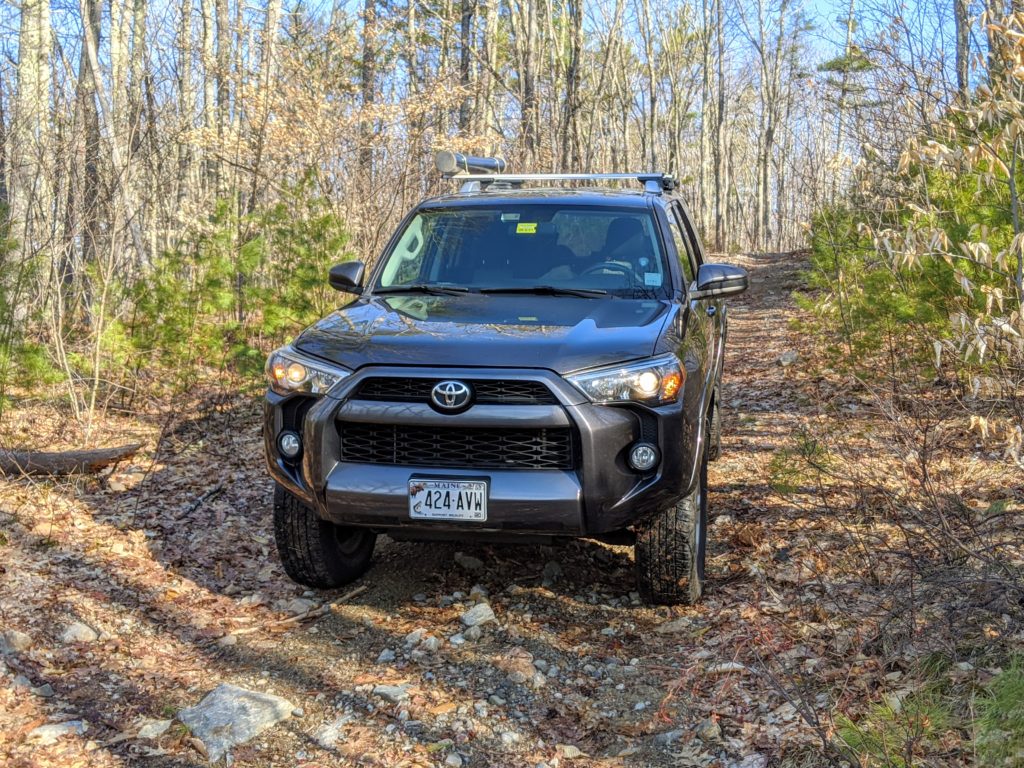
Lessons Learned
As this trip was a baseline to gauge where to make my improvements to the trucks in order to be a card-carrying “Overlander”, I really looked back and reviewed the whole trip in an effort to plan future improvements to my beloved 4Runner. What did I come up with?
- Bring an air mattress. I have an inflatable ground pad meant for camping, but where it’s only a couple inches tall when fully inflated, I doubt it would do much for me to alleviate sore bones from that seat-hinge ridge. For the near future, I’ll dive into my air mattress stash and see which one fits best in the back of the 4Runner and use that. Also, surely this issue has been discovered before I found it – I’m hoping to mine some information from forums and maybe even you, dear reader – on products that will enhance my sleeping comfort while using the back of a 5th gen Toyota 4Runner as a rolling hotel.
- Keys need a dedicated, easily-accessible area in the back of a 4Runner in case you need a hasty evacuation. The coat hanger hook might work, but I’m thinking a small hinged box VHB taped to a pillar would work better, and ensure the keys didn’t get accidentally knocked off the hook while throwing the covers off on a hot night.
- I need a battery booster pack. With the boy constantly going in and out of the truck and leaving doors open, plus the fact that we left the rear hatch open pretty much the whole time we weren’t sleeping, I was in fear that the interior lights being on would drain that battery just a little too much, and I’d be stranded. A booster pack would have alleviated that little aggravation and helped me relax and enjoy the trip more. I’m told you can use an 18 or 20 volt cordless drill battery to jump start a vehicle. I’ll try it someday, but unless it’s a ridiculously reliable system, I’ll go with what I know works.
- Cracking the rear hatch window to help alleviate breath condensation on the glass and headliner definitely helped, but you need to watch the direction of the prevailing breeze when you park. All night we had a light breeze blowing 27 degree air into the cabin. If I hadn’t already set the awning up to the roof rack utility tube, I would have moved the truck. But hey, at least there weren’t any bugs.
- With all the glass in the back of a 4Runner, I’m not looking forward to summer getaways with the sun blaring in the glass and raising internal temps due to solar heat gain. There’s always A/C, but nobody wants to leave their vehicles running all night. Battery powered fans? Open the windows and install screens? What about the bears my son was afraid of?
- Since the rear hatch of a 5th gen 4Runner isn’t able to be opened from the inside (at least on my SR5 base model), evacuations have to be made through the rear seat passenger doors. Don’t leave gear or detritus in front of these doors or below them – doing the body extrication yoga necessary to bail out is tough enough without worrying about trip hazards when you finally get past the door frame.
- A proper roof rack mounted basket will be a must-have accessory coming up here soon. Half the gear I have stowed in the back could have been carried on the roof rack, eliminating the need to transfer a ton of gear to the front seats.
- A folding trailer hitch cargo basket is worth its weight in gold when camping. It’s a cargo area (obviously), but it’s a great staging area to put gear while you’re loading up the back of the 4Runner. It’s also a great (if a little low) table – we plunked the Coleman stove and burner right on the deployed basket and cooked like a boss.
- An awning is a great way to keep the sun off you and keep items from getting rain or frost on them over a cold night. It’s also a great place to hang lights like my Biolite 620 setup – which also boasts a little radio so you can blast Weezer and keep the fearsome bears your son is afraid of out of camp while you cook. My awning is a simple tarp with grommets held up with collapsible tent poles and guy lines made from paracord, and it works great. However, I can see myself upgrading to a nice commercial model here in the near future – they’re not as pricey as I thought they were.
Well, there it is – my initial lessons learned from my first internal-camping outing in my 5th gen Toyota 4Runner. I’m positively right in love with this rig, and I’m looking forward to upgrading it to be an even better machine to handle future excursions into the wilderness with my family. Maybe it’ll even be comfortable enough for the wife to tag along someday. But probably not.
